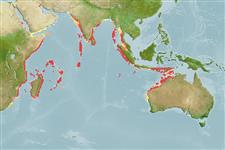Environment: milieu / climate zone / depth range / distribution range
Ökologie
seewasser; brackwasser riff-verbunden. Tropical
Western Indian Ocean: Mozambique, Mauritius, Reunion (Ref. 54356), and Seychelles. Probably more wide-ranging in the area. Western Central Pacific: Guam (Ref. 35720) and Australia (Ref. 2334).
Length at first maturity / Size / Gewicht / Alter
Maturity: Lm 35.0 range ? - ? cm
Max length : 60.0 cm SL Männchen/unbestimmt; (Ref. 37792)
Rückenflossenstacheln (insgesamt): 5; Rückenflossenweichstrahlen (insgesamt): 26-29; Afterflossenstacheln 2; Afterflossenweichstrahlen: 26 - 28. Small blackish spots usually present, at least dorsoanteriorly on body. Adults with a large bulbous protuberance at front of snout (Ref 9808).
Occurs in coral reefs. Diet consisted a high proportion of the green alga, Caulerpa.
Life cycle and mating behavior
Geschlechtsreife | Fortpflanzung | Ablaichen | Eier | Fecundity | Larven
Randall, J.E., 2001. Surgeonfishes of Hawai'i and the world.. Mutual Publishing and Bishop Museum Press, Hawai'i. 123 p. (Ref. 37792)
IUCN Rote Liste Status (Ref. 130435)
Bedrohung für Menschen
Harmless
Nutzung durch Menschen
Mehr Information
ReferenzenAquakulturAquakultur ProfilZuchtlinienGenetikElectrophoresesVererbbarkeitKrankheitenVerarbeitungNutrientsMass conversion
PartnerBilderStamps, Coins Misc.LauteCiguateraGeschwindigkeitSchwimmstilKiemenoberflächeOtolithsGehirngrößeSehfähigkeit
Tools
Zusatzinformationen
Download XML
Internet Quellen
Estimates based on models
Preferred temperature (Ref.
123201): 24.5 - 29, mean 27.5 °C (based on 294 cells).
Phylogenetic diversity index (Ref.
82804): PD
50 = 0.5000 [Uniqueness, from 0.5 = low to 2.0 = high].
Bayesian length-weight: a=0.01995 (0.00906 - 0.04395), b=3.00 (2.82 - 3.18), in cm total length, based on LWR estimates for this Genus-body shape (Ref.
93245).
Trophic level (Ref.
69278): 2.0 ±0.00 se; based on food items.
Generation time: 2.6 ( na - na) years. Estimated as median ln(3)/K based on 1
growth studies.
Widerstandsfähigkeit (Ref.
120179): mittel, Verdopplung der Population dauert 1,4 - 4,4 Jahre. (tm=4; K=0.428; Tmax=25).
Fishing Vulnerability (Ref.
59153): Low to moderate vulnerability (33 of 100).
Nutrients (Ref.
124155): Calcium = 37.1 [21.6, 74.3] mg/100g; Iron = 0.587 [0.284, 1.028] mg/100g; Protein = 19 [18, 20] %; Omega3 = 0.138 [0.084, 0.262] g/100g; Selenium = 40.8 [20.9, 80.9] μg/100g; VitaminA = 36.2 [10.4, 119.7] μg/100g; Zinc = 1.59 [1.07, 2.32] mg/100g (wet weight);
